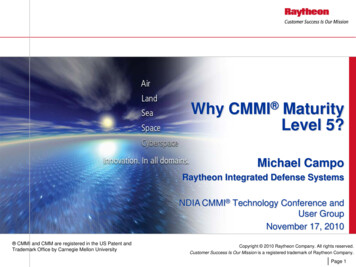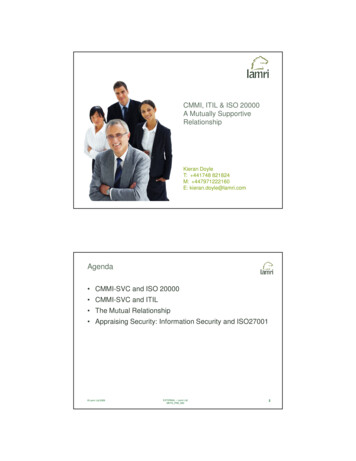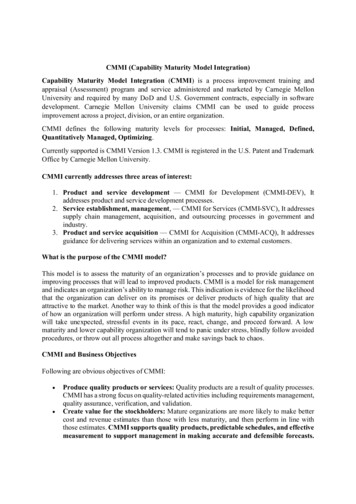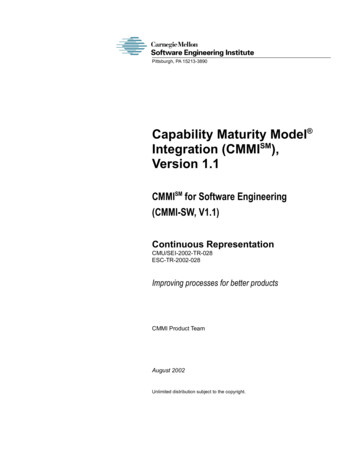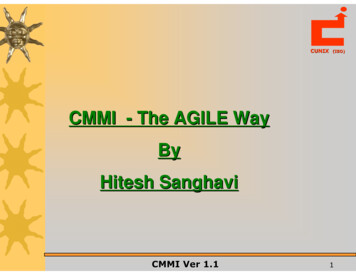
Transcription
CUNIX(ISO)CMMI - The AGILE WayByHitesh SanghaviCMMI Ver 1.11
The Maturity LevelsCUNIX(ISO)Optimizing5Focus on process improvementQuantitatively4ManagedProcess measured and controlled3Process characterized for theDefinedorganization and is proactive2 Processcharacterized forManagedprojects and is often reactiveInitial1Process unpredictablepoorly controlled, andreactiveCMMI Ver 1.12
3 Flavors of CMMI –SE/SW/IPPD/SS, StagedCUNIXCMMI Ver 1.1(ISO)3
PA CategoriesCUNIX(ISO)CMMI ProcessManagementProjectManagement Organizational Process Focus Project Planning Organizational ProcessDefinition Organizational Training Organizational ProcessPerformance Organizational Innovationand Deployment Project Monitoring andControl Supplier Agreement Mgmt. Integrated Project Mgmt. Risk Management Quantitative Project Mgmt.IPPDEngineeringSupport Requirements Management Requirements Development Technical Solution Product Integration Verification Validation Configuration Mgmt. Process and ProductQuality Assurance Measurement & Analysis Decision Analysis andResolution Causal Analysis andResolutionSupplierSourcing Organizational Environment Supplier Selection and Monitoringfor Integration Integrated Teaming Integrated Supplier Management Quantitative Supplier ManagementCMMI Ver 1.14
Project Monitoring and ControlCUNIX(ISO) Purpose: Provide understanding into the project’s progressso that appropriate corrective actions can be taken when theproject’s performance deviates significantly from the plan.CMMI Ver 1.15
Technical Solution – Context 1CUNIXCMMI Ver 1.1(ISO)6
CMMI - Generic PracticesCUNIX(ISO)Generic practices for all maturity level 2 process areas:GP 2.1: Establish an Organizational PolicyGP 2.2: Plan the ProcessGP 2.3: Provide ResourcesGP 2.4: Assign ResponsibilityGP 2.5 : Train PeopleGP 2.6: Managed ConfigurationsGP 2.7: Identify and Involve Relevant StakeholdersGP 2.8 : Monitor and Control the ProcessGP 2.9: Objectively Evaluate AdherenceGP 2.10: Review Status with Higher Level ManagementGP 3.1: Establish a Defined ProcessGP 3.2: Collect Improvement InformationCMMI Ver 1.17
A Brief Overview of Agile Agile methods is a unique and effective hybrid approach (Extreme Prog-XP, SCRUM, Crystal,Lean Development) toSW development that retains the core elements of (XP). ITrecommend very down-to-earth, actionable practices such ascontinuous integration, test-first programming, and refactoringAgile development is:- Essential streamlined Highly disciplined processes- No nonsense, intensely practical- Bias towards action- Flexible, adaptable and speed-to-market- Execution with swiftness and precision81
AGILE AdvantagesCUNIX(ISO)AGILE provides a uniquely effective approaches for. optimizing development team productivity (OID) minimizing risk (RSKM) ensuring end-user satisfaction and support (RM) rapidly and continuously delivering high-value workingsoftware to end-users (IPM) delivering the ROI that business and technical leaders alikedemand from software projects(MA) The ability to deal with incomplete and unstable requirements More effective control over schedule and costs The right balance between agility and rigor A much more enriching and satisfying way to develop software A happier customerCMMI Ver 1.19
Extreme Programming(Kent Beck, Ron Jeffries, and Ward Cunningham)CUNIX(ISO) XP’s target is small to medium sized teams buildingsoftware with vague or rapidly changing requirements.XP teams are typically collocated and have fewer than10 members. XP’s critical underlying assumption is that developerscan obviate the traditional high cost of change usingtechnologies such as objects, patterns, and relationaldatabases, resulting in a highly dynamic XP process. XP teams typically deal with requirements changesthrough an iterative life cycle with short cycles.CMMI Ver 1.110
The XP life cycleCUNIX(ISO)The XP life cycle has four basic activities: Coding (TS), testing(V-V), listening(RM-PMC,RSKM), anddesigning(TS).XP dynamism is demonstrated through four values: Continual communication with the customer and within the team;(GP 2.7,2.8,IPM) Simplicity, achieved by a constant focus on minimalist solutions;(RD,TS SP2.4) Rapid feedback through mechanisms such as unit and functionaltesting;(VV) The courage to deal with problems proactively.(RSKM)CMMI Ver 1.111
12 XP Elements -1 :CUNIX(ISO) 1. Planning game: Quickly determine the next release’sscope(PP), combining business priorities and technicalestimates(PP). The customer decides scope, priority, anddates from a business perspective, whereas technical peopleestimate and track progress(PMC). 2. Small releases: Put a simple system into productionquickly. Release new versions on a very short (2-3-week)cycle. (OPD - SP1.2 [LC] and 1.3 [TG]) 3. Metaphor: Guide all development with a simple, sharedstory of how the overall system works. (RM & RD, IPM,GP2.7 ) 4. Simple design: Design as simply as possible at any givenmoment.(RD,TS)CMMI Ver 1.112
XP Elements -2 :CUNIX(ISO) 5. Testing: Developers continually write flawlessle running unit tests(V-V); customers write tests to demonstrate that functions are finished.“Test, then code” means that a failed test case is an entry criterion forwriting code. 6. Refactoring: Restructure the system without changing its behaviorto remove duplication(RM-SP1.4[RTM]), improve communication(GP 2.7), simplify or add flexibility.(RM-SP 1.5- [Id Inconsistencies]) 7. Pair programming: All production code is written by twoprogrammers (GP 2.3,2.4,2.5,2.7) at one machine. For a jelledteam(IT), the effort increase(PMC) can be as little as 15% (MAA,GP2.2,2.8 ), while cycle time is reduced by 40 to 50 %. 8. Collective ownership: Anyone can improve any system codeanywhere at any time.(GP 2.7,GP 2.6)CMMI Ver 1.113
XP Elements -3 :CUNIX(ISO) 9.Continuous integration: Integrate and build the systemmany times a day (every time a task is finished). Continualregression testing prevents functionality regressions whenrequirements change. (PI) 10. 40-hour weeks: Work no more than 40 hours per weekwhenever possible; never work overtime two weeks in a row.(PP,PMC) 11. On-site customer: Have an actual user on the team fulltime to answer questions. (IPM loose mapping) 12. Coding standards: Have rules that emphasizecommunication throughout the code.(TS)CMMI Ver 1.114
XP MetricsCUNIX(ISO) The basic XP management tool is the metric,and the metric’s medium is the “big visiblechart.” In the XP style, three or four measuresare typically all a team can stand at one time,and those should be actively used and visible. One recommended XP metric is “projectvelocity”—number of stories of a given size thatdevelopers can implement per iteration. (MA)CMMI Ver 1.115
Can CMMI and Agile Co-existCUNIX(ISO) Success in any endeavor requires both agility anddiscipline Two approaches to software development– Plan-driven (SW-CMMI, document-based, strongprocess)– Agile (XP, tacit knowledge, light process) Agile and plan-driven proponents are believers Both have strengths and weaknesses – balance is neededCMMI Ver 1.116
AGILE - People over ProcessCUNIX(ISO) Development is “of the people, by the people, for thepeople” Separation of concerns is increasingly harmfulCMMI Ver 1.117
Philosophy of CMMI with AgileThe most important thing to understand about the CMMI isthat it is all about achieving the goals.The CMMI prescribes what must be achieved to have aneffective process, not how to go about reaching the goalsAgile is unique in that it permits an organization to deployagile methods with their attendant advantages, andsimultaneously, achieve compliance with the CMMIIllustration: See Goalwise Compliance181
Balanced Methods are EmergingCUNIX(ISO) Agile methods– Crystal Orange– DSDM– FDD Plan-Driven methods– Rational Unified Process– CMMI Hybrid– Boehm-Turner Risk-based– Manzo (AgileTek) CodePlusCMMI Ver Science/Agile1.119
AGILE RecommendationsCUNIX(ISO) Make incremental change to the requirements, projectplan system, and the resulting artefacts to enable agility. Strive for rapid feedback to ensure the project meets theneeds of all the participants and stakeholder. Manage with a purpose, performing only those tasks thatadd value to business processes supported by the system. Travel light, discarding processes and artefacts that don’tadd enduring value to the product — a working softwaresystem.CMMI Ver 1.120
High Maturity with CMMICUNIX(ISO) Innovation at level 5 argues for agile approaches Having both agile and plan-driven standardprocesses allows marketplace agility Application of Lean and Six Sigma techniquesat high maturity levels eliminates non-valueadded processes and results in more agile tailorup rather than tailor-down approachesCMMI Ver 1.121
Mapping Agile to theCMMIThis map illustrates which Agile practices fulfill the goalsof which PasFor the purposes of the map, the following abbreviations areused for the Agile practices221
231
241
251
261
271
281
Misconceptions About AgileAgile Methods : Add Risk to a Project Don’t Scale (for large long term projects) Won’t Work in a Regulated Environment Incompatible With the Software CMM and CMMI291
ConclusionsUsing Agile to achieve CMMI Level 2 and 3 will provideseveral benefits that might not otherwise accrue:301
CUNIX(ISO)THANK-YOUCMMI Ver 1.131
CMMI Ver 1.1 21 High Maturity with CMMI Innovation at level 5 argues for agile approaches Having both agile and plan-driven standard processes allows marketplace agility Application of Lean and Six Sigma techniques at high maturity levels eliminates non-value added processes and results i
